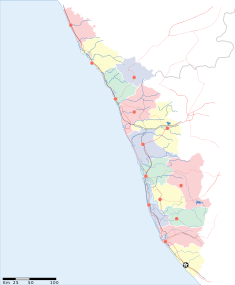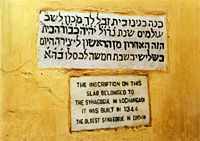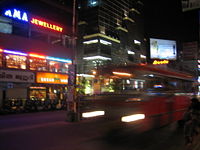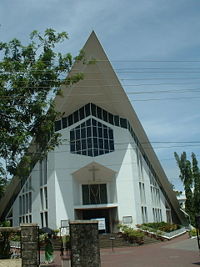Kochi, India
| കൊച്ചി Kochi Kerala • India | |
| Nickname: Queen of the Arabian Sea[1][2] | |
| Coordinates: | |
| Time zone | IST (UTC+5:30) |
| Area • Elevation • Coastline |
94.88 km² (37 sq mi) • 0 m (0 ft) • 48 km (30 mi) |
| Climate • Precipitation |
Am (Köppen) • 3,228.3 mm (127.1 in) |
| Distance(s) • From Mumbai • From Delhi • From Chennai |
• 1,384 km NW (land) • 2,594 km N (land) • 684 km NE (land) |
| District(s) | Ernakulam |
| Population • Density • Metro • Sex ratio • Literacy rate |
601,574[3] (2011) • 6,340 /km² (16,421 /sq mi) • 2,117,990[4] (2011) • 1.028 • 97.5 |
| Mayor | Tony Chamminy (INC) |
| City Police Commissioner | M.R. Ajith Kumar IPS |
| Codes • Pincode • Telephone • UN/LOCODE • Vehicle |
• 682 0XX • +91-(0)484-XXX XXXX • INKOC • KL-7, KL- 39 to 43 |
| Website: www.corporationofcochin.net | |
Coordinates:
Kochi ; Malayalam: കൊച്ചി [koˈʧːi]); formerly known as Cochin), a city in the Indian state of Kerala, serves as the commercial capital of Kerala. The city, one of the principal seaports of the country, sits in the district of Ernakulam, about 220 kilometers (137 mi) north of the state capital, Thiruvananthapuram. It has an estimated population of 600,000, with an extended metropolitan population of about 1.5 million, making it the largest urban agglomeration and the second largest city in Kerala after the capital.
Since 1102 C.E., Kochi has been the seat of the Kingdom of Cochin, a princely state which traces its lineage to the Kulasekhara empire. Heralded as the Queen of the Arabian Sea, Kochi has been an important spice trading center on the Arabian Sea coast from the fourteenth century onwards. Ancient travelers and tradesmen referred to Kochi in their writings, variously alluding to it as Cocym, Cochym, Cochin, and Cochi. Occupied by the Portuguese in 1503, Kochi became the site of the first European colonial settlement in India. It remained the capital of Portuguese India until 1530, when Goa became the capital. The Dutch later occupied the city, followed by the Mysore and the British. Kochi had been the first princely state to willingly join the Indian Union, when India gained independence in 1947.
Kochi experienced decades of economic stagnation from independence until 2003, when it entered a period of economic growth, leading to a spurt in the city's development. A growing center of information technology, tourism and international trade, Kochi has become the commercial hub of Kerala, and one of the fastest growing second-tier metros in India. Like other large cities in the developing world, Kochi continues to struggle with urbanization problems such as traffic congestion and environmental degradation. Successive waves of migration over the course of several millennia have made Kochi a cultural melting pot. Despite the risk of over development, the city retains its distinct colonial heritage and a blend of tradition and modernity.
| This article contains Indic text. Without proper rendering support, you may see question marks or boxes, misplaced vowels or missing conjuncts instead of Indic text. |
Name
Theories regarding the etymology of the name "Kochi" have been disputed.[5] One suggests that the city's modern name derives from the Malayalam word koch azhi, meaning 'small lagoon'. Another version mentions the name as derivative of the Sanskrit word Go shree which means 'prosperous with cows'. Certain ancient texts refer to the city Balapuri (Sanskrit for 'small town'), which became Cochin in course of time.
According to some accounts, traders from the court of the Chinese ruler Khubilai Khan gave Cochin the name of their homeland. Yet another theory puts forward that Kochi derived from the word Kaci meaning 'harbor'. Certain scholars claim that Cochin derives from the term Cocha, a transfiguration of the Biblical term Cohen.[5] Accounts by Italian explorers Nicolo Conti (fifteenth century), and Fra Paoline in the seventeenth century say that Kochchi came from the name of the river connecting the backwaters to the sea.
After the arrival of the Portuguese, and later the British, the name Cochin stuck as the official appellation. The city reverted to a closer anglicization of its original Malayalam name, Kochi, in 1996, although many still still use the name Cochin.
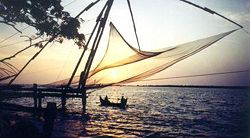

History
Kochi, the center of Indian spice trade for many centuries, had been known to the Yavanas Greeks as well as Romans, Jews, Arabs, and Chinese since ancient times.[6] Kochi rose to significance as a trading center after massive flooding of the river Periyar destroyed the port at Kodungallur (Cranganore) in 1341. The earliest documented references to Kochi occur in books written by Chinese voyager Ma Huan during his visit to Kochi in the fifteenth century as part of Admiral Zheng He's treasure fleet.[7] References to Kochi in accounts written by Italian traveler Niccolò Da Conti, who visited Kochi in 1440, also exist.[8]
The Kingdom of Kochi came into existence in 1102, after the fall of the Kulasekhara empire.[9] The King of Kochi had authority over the region encompassing the present city of Kochi and adjoining areas. A hereditary reign, the Cochin Royal Family (Perumpadappu Swaroopam in the local vernacular) ruled over Kochi. Mainland Kochi remained the capital of the princely state since the eighteenth century. During much of that time, the kingdom suffered under foreign rule, and the King often only had titular privileges.
Fort Kochi in Kochi had been the first European colonial settlement in India. From 1503 to 1663, Portugal ruled Fort Kochi. That Portuguese period had been difficult for the Jews in the region, since Portuguese actively pursued the Inquisition in India. Kochi hosted the grave of Vasco da Gama, the first European explorer to set sail for India, buried at St. Francis Church until the Catholic church returned his remains to Portugal in 1539.[10] The Dutch followed the Portuguese rule. They had allied with the Zamorins to conquer Kochi. By 1773, the Mysore King Hyder Ali extended his conquest in the Malabar region to Kochi forcing it to become a tributary of Mysore. The hereditary Prime Ministership of Kochi held by the Paliath Achans came to an end during this period.
Meanwhile, the Dutch, fearing an outbreak of war on the United Provinces signed a treaty with the United Kingdom, under which Holland ceded Kochi to the United Kingdom in exchange for the island of Bangka. Evidence of English habitation in the region even prior to the signing of the treaty exists.[11] In 1866, Fort Kochi became a municipality, conducting its first Municipal Council election in 1883. The Maharaja of Cochin, who ruled under the British, in 1896 initiated local administration by forming town councils in Mattancherry and Ernakulam. In 1925, public pressure on the state encouraged the constitution of the Kochi legislative assembly.
Approaching the early twentieth century, trade at the port had increasing substantially, and the need to develop the port became keenly felt. Harbor engineer Robert Bristow came to Kochi in 1920 under the direction of Lord Willingdon, then the Governor of Madras. In a span of 21 years, he transformed Kochi as one of the safest harbors in the peninsula, where ships berthed alongside the newly reclaimed inner harbor equipped with a long array of steam cranes.[12]
In 1947, India gained independence from the British colonial rule. Cochin stood as the first princely state to join the Indian Union willingly.[13] In 1949, Travancore-Cochin state came into being with the merger of Cochin and Travancore. The Rajpramukh of the Travancore-Cochin Union reigned as the King of Travancorefrom 1949 to 1956. Travancore-Cochin, in turn, merged with the Malabar district of the Madras State. Finally, the Government of India's States Reorganisation Act (1956) inaugurated a new state—Kerala—incorporating Travancore-Cochin (excluding the four southern Taluks which merged with Tamil Nadu), Malabar District, and the taluk of Kasargod, South Kanara.[14] On July 9, 1960, the Mattancherry council passed a resolution—forwarded to the government—requesting the formation of a municipal corporation by combining the existing municipalities of Fort Kochi, Mattancherry, and Ernakulam. The government appointed a commission to study the feasibility of the suggested merger. Based on its report, the Kerala Legislative Assembly approved the corporation's formation. On November 1, 1967, exactly 11 years since the establishment of the state of Kerala, the corporation of Cochin came into existence. The merger leading to the establishment of the corporation, took place between the municipalities of Ernakulam, Mattancherry and Fort Kochi, along with that of the Willingdon Island, four panchayats (Palluruthy, Vennala, Vyttila and Edappally), and the small islands of Gundu and Ramanthuruth.
Kochi witnessed economic stagnation in the years following India's independence. The city's economic recovery gathered momentum after economic reforms in India introduced by the central government in the mid-1990s. Since 2000, the service sector has revitalized the city’s stagnant economy. The establishment of several industrial parks based on Information technology (IT) triggered a construction and realty boom in the city. Over the years, Kochi has witnessed rapid commercialization, and has today grown into the commercial capital of Kerala.[15]
Geography and climate
Kochi, located on the southwest coast of India at 9°58′N 76°13′E, spans an area of 94.88 square kilometers (36.63 sq mi). The city sits at the northern end of a peninsula, about 19 kilometers (12 mi) long and less than one mile (1.6 km) wide. To the west lies the Arabian Sea, and to the east perennial rivers originating in the Western Ghats drain estuaries. Much of Kochi lies at sea level, with a coastline of 48 km.[16]
The current metropolitan limits of Kochi include the mainland Ernakulam, old Kochi, the suburbs of Edapally, Kalamassery and Kakkanad to the northeast; Tripunithura to the south east; and a group of islands closely scattered in the Vembanad Lake. Most of those islands, small in size, vary in extent from six square kilometers to less than a square kilometer (1,500 to less than 250 acres).
Soil consists of sediments such as alluvium, teri's, and brown sands. Hydromorphic saline soils cover areas surrounding the backwaters.[17] Predominant rock types include Archaean-basic dykes, Charnockites and Gneisses. An ecologically sensitive area, the Mangalavanam Bird Sanctuary in the central part of the city has a wide range of mangrove species. It serves as a nesting ground for a vast variety of migratory birds. Certain species of dolphins live in the backwaters.
Kochi's proximity to the equator, along with its coastal location, results in little seasonal temperature variation with moderate to high levels of humidity. Annual temperatures range between 20 to 35 °C (68–95 °F) with the record high being 38 °C (100 °F), and record low 17 °C (63 °F).[18] From June through September, the south-west monsoon brings in heavy rains as Kochi lies on the windward side of the Western Ghats. From October to December, Kochi receives light rain from the northwest monsoon, as it lies on the leeward side. Average annual rainfall is 3,500 millimetres (138 in), with an annual average of 132 rainy days.
Civic administration
The Kochi Corporation, headed by a mayor, administers the city. Administratively, the city divides into 70 wards, with members of the corporation council elected for a period of five years. The Corporation has its headquarters in Ernakulam, and zonal offices at Fort Kochi, Mattancherry, Palluruthy, Edappally, Vaduthala and Vyttila. The Personnel Department and the Council Section handle the general administration of the city. Other departments include that of town planning, health, engineering, revenue and accounts.[19] The corporation manages waste disposal, sewage management and the supply of potable water, sourced from the Periyar River.[20] The Kerala State Electricity Board provides electricity.
The Greater Cochin Development Authority (GCDA) government agency oversees the development of Kochi. The Kochi City Police, headed by a Police Commissioner, an Indian Police Service (IPS) officer, comprises the traffic police, Narcotics Cell, Armed Reserve Camps, District Crime Records Bureau, Senior citizen's Cell, and a Women's Cell.[21] It operates nineteen police stations functioning under the Home Ministry of State Government. An anti-corruption branch of the Central Bureau of Investigation also operates out of the city. Kochi serves as the seat of the High Court of Kerala, the highest judicial body in the state. The High Court also has jurisdiction over the Union Territory of Lakshadweep.
Kochi contributes five seats to the State Assembly, and a seat to the Lok Sabha, the Lower House of the Indian Parliament.
Economy
Kochi presides as the economic capital of Kerala by volume of trade. Unlike other South Indian cities, Kochi has been slow to industrialize.[15] In recent years the city has rejuvenated from its economic stagnation and has witnessed heavy investment, thus making it one of the fastest-growing second-tier metro cities in India.[22] The economy of the city can be classified as a business economy with emphasis on the service sector.[23] Major business sectors include gold and textile retailing, seafood and spices exports, information technology (IT), tourism, health services, banking, shipbuilding, and the fishing industry. The economy depends mostly on trade and retail activities.[24] As in most of Kerala, remittances from non-resident Indians (NRI)s provides a major source of income. The city also houses Kerala's only bourse—the Cochin Stock Exchange.
Kochi has been a magnet for IT and ITES companies, ranked by NASSCOM as the second-most attractive city in India for IT-based services.[25] Availability of cheap bandwidth through undersea cables and lower operational costs compared to other major cities in India, has been to its advantage. Various technology and industrial campuses including the government promoted InfoPark, Cochin Special Economic Zone and KINFRA Export Promotion Industrial Park operate in the outskirts of the city. Several new industrial campuses for research, trade and development in biotechnology, electronic hardware and information technology have been under construction in the suburbs of the city. the Sobha Hi-tech city at Maradu and the SmartCity at Kakkanad, which on completion, would rank among the largest such ventures in the country stand out among them.[26] The Cochin International Airport has been in the process of setting up an aerotropolis at Nedumbasserry.
Eloor, situated 17 kilometers (10.5 mi) north of the city, constitutes the largest industrial belt in Kerala, with more than 250 industries manufacturing a range of products including chemical and petrochemical products, pesticides, rare earth elements, rubber processing chemicals, fertilizers, zinc and chromium compounds, and leather products.
Kochi serves as the headquarters of the Southern Naval Command, the primary training center of the Indian Navy.[27] The Cochin Shipyard in Kochi constitutes the largest shipbuilding facility in India. The Cochin fishing harbor, located at Thoppumpady, acts as a major fishing port in the state and supplies fish to local and export markets. To further tap the potential of the all-season deep-water harbor at Kochi, an international cruise terminal and several marinas have been under construction.[28]
Exports and allied activities also contribute to the city's growing economy. The Cochin Port currently handles export and import of container cargo at its terminal at Willington Island. A new international container transshipment terminal—the first in the country—has been commissioned at Vallarpadam.[29] Kochi's historical reliance on trade continues into modern times, as the city has been a major exporter of spices as well as the home to the International Pepper Exchange, a global center for the trade of black pepper. The Spices Board of India headquarters in Kochi.
Kochi has an oil refinery—the Kochi Refineries Limited (KRL) at Ambalamugal. Central Government establishments like the Coconut Development Board, the Coir Board and the Marine Products Export Development Authority (MPEDA) have head offices located in the city.
Transport
Public transport in the city depends largely on private buses. Taxis and autorickshaws (called autos) cruise the streets for hire throughout the day. Narrow roads and the mix of vastly differing types of vehicles have made traffic congestion a major problem in the city. A metro rapid transit service, intended to considerably ease congestion, is planned for the city.[30]
As one of the safest harbors in the Indian Ocean, Kochi ranks among India's major seaports. The port, administered by a statutory autonomous body known as the Cochin Port Trust, offers facilities for bunkering, handling cargo and passenger ships and storage accommodation. It also operates passenger ships to Colombo and Lakshadweep. Boat services operated by Kerala Shipping and Inland Navigation Corporation, the State Water Transport Department, and of private ownership originate from various boat jetties in the city. The junkar ferry for the transshipment of vehicles and passengers between the islands operate between Ernakulam and Vypin, and between Vypin and Fort Kochi. With the construction of the Goshree bridges (which links Kochi's islands), ferry transport has become less essential.
The Cochin International Airport, about 25 kilometers (15 mi) north of the city, handles both domestic and international flights. As the largest airport of Kerala, and one of the busiest in India, Cochin International Airport became the first international airport in India built without Central Government funds.[31] An airport run by the Navy also operates in the city. A third airport, for use by the Indian Coast Guard, has been under construction in the suburbs.
No intra-city rail transport system exists in Kochi. The Southern Railway division of the Indian Railways administers the inter-city rail transport system in the city. Two main railway stations—the Ernakulam Junction and the Ernakulam Town (locally known as the 'South' and 'North' railway stations respectively)operate in Kochi. The railway line connecting those two stations cuts the city longitudinally in two, with two narrow bridges connecting the two halves.
Demographics
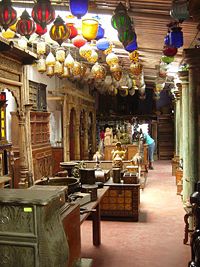
As of 2001, Kochi had a population of 596,473, with a density of 6850.7 persons per square kilometer.[32] Scheduled castes and tribes comprise 14.3 percent of the city's population. The female-to-male ratio is 1,024:1,000, significantly higher than the all-India average of 933:1,000. Kochi's literacy rate stands at 94.3 percent.[32] The female literacy rate lags that of males by 1.1 percent, amongst the lowest such gaps in India.
Hinduism, Christianity, and Islam rank as Kochi's major religions; Jainism, Judaism, Sikhism, and Buddhism have smaller followings. Though 47 percent practice Hinduism, Christianity's large following (35 percent) makes Kochi a city with one of the largest Christian populations in India.[33] Malayalis make up the majority of residents with significant ethnic minority communities including Tamils, Gujaratis, Jews, Sikkimese, Anglo-Indians, Konkanis, and Tulus. Malayalam ranks as the main language of communication and medium of instruction, although people use English more commonly used in business circles. People understand Hindi and Tamil widely although they rarely speak it.
Like other fast-growing cities in the developing world, Kochi suffers from major urbanization problems, poor sanitation, and unemployment. The city registered an increase of 9.7 percent in its unemployment rate from 14.8 percent in 1998 to 24.5 percent in 2003.[34] Shortage of potable water has been a major concern in the city.[35] The threat posed by pollution in industrial areas aggravates the situation.[36] The city also has a growing slum-dwelling population.[37] Kochi has a high suicide rate with thirty two suicides per lakh, three times higher than the national average of 11.2 per lakh.[38] According to the National Crime Records Bureau, Kochi has one of highest rates of crime in India—498.6, against the national average of 287.3.[39] A survey conducted by The Week, found Kochi to be the safest city in India for women.
Culture
As a result of successive waves of migration over the course of several centuries, the population of the city has become a mix of people from all parts of Kerala and most of India. The substantial presence of various ethnic communities from different parts of the country highlights the pan-Indian nature of the city. Kochi has a diverse, multicultural, and secular community consisting of Hindus, Christians, Muslims, Jains, Sikhs, and Buddhists among other denominations, all living in peaceful co-existence. The city once had a large Jewish community, known as the Malabar Yehuden—and now increasingly as Cochin Jews—that figured prominently in Kochi's business and economic strata.[40] The Syro-Malabar Church, one of the 22 sui iuris Eastern Catholic Churches, has its seat at Ernakulam. Appropriate to its multi-ethnic composition, Kochi celebrates traditional Kerala festivals like Onam and Vishu along with North Indian Hindu festivals like Holi and Diwali with great fervor. Christian and Islamic festivals like Christmas, Easter, Eid ul-Fitr and Milad-e-sherif take place. A merry making fest called the Cochin Carnival takes place at Fort Kochi during the last ten days of December.
Residents of Kochi, known as Kochiites, play an important part in the South Indian weltanschauung. The city's culture has been rapidly evolving, with Kochiites generally becoming more cosmopolitan in their outlook.
Kochiites widely partake of Keralite cuisine, generally characterized by an abundance of coconut and spices. Other South Indian cuisines, as well as Chinese and North Indian cuisines have won popularity.
Kochi had been home to some of the most influential figures in Malayalam literature, including Changampuzha Krishna Pillai, Kesari Balakrishna Pillai, G. Sankara Kurup, and Vyloppilli Sreedhara Menon. Prominent social reformers such as Sahodaran Ayyappan and Pandit Karuppan also came from Kochi.
Kochiites have become known for their enthusiasm in sports, especially cricket and football.[41] The Jawaharlal Nehru International Stadium in Kochi constitutes one of the largest multi-use stadiums in India.[42] The Regional Sports Centre has become an important center of sporting activity in the city.
Education
The government or private trusts and individuals run schools and colleges in the city, affiliated with the Indian Certificate of Secondary Education (ICSE), the Central Board for Secondary Education (CBSE), or the Kerala State Education Board. English serves as the medium of instruction in most private schools; government run schools offer both English and Malayalam. After completing their secondary education, which involves ten years of schooling, students typically enroll at Higher Secondary School in one of the three streams—Arts, Commerce or Science. Upon completing the required coursework, the student can enroll in general or professional degree programs.
The Cochin University operates in the city. Most of the colleges offering tertiary education affiliate either with the Mahatma Gandhi University or the Cochin University. Other national educational institutes include the Central Institute of Fisheries Nautical and Engineering Training, the National University of Advanced Legal Studies, the National Institute of Oceanography and the Central Marine Fisheries Research Institute.
Media
Major Malayalam newspapers published in Kochi include Malayala Manorama, Mathrubhumi, Deshabhimani, Deepika, Kerala Kaumudi and Veekshanam. Popular English newspapers include The Hindu, The New Indian Express and The Pioneer. A number of evening papers also publish from the city.[43] Newspapers in other regional languages like Hindi, Kannada, Tamil and Telugu also sell in large numbers.
Being the seat of the Cochin Stock Exchange, a number of financial publications also publish in the city. Those include The Economic Times, Business Line, The Business Standard and The Financial Express. Prominent magazines and religious publications like the Sathyadeepam, The Week and Vanitha also published from the city. Television stations in Kochi include Asianet Cable Vision, India Vision, Kairali TV, Jeevan TV, Amrita TV, JaiHind TV and Manorama News. Satellite television provide services through Doordarshan Direct Plus, Dish TV and Tata Sky. All India Radio has two FM stations in the city, operating at 102.3 MHz and 107.5 MHz. Private satellite radios such as WorldSpace, also transmit. Over twenty cinema halls operate screening movies in Malayalam, Tamil, English and Hindi. A film festival, known as the Cochin International Film Festival (CIFF), runs in the city every year.
Kochi has the highest density of telephones in India. Airtel, Idea cellular, Vodafone, Reliance Infocomm, Tata Indicom and the state owned BSNL Telephony provide services.
See also
Notes
- ↑ K. C. Sivaramakrishnan, People's Participation in Urban Governance (Concept Publishing Company, 2006, ISBN 8180693260), 156.
- ↑ Ganesh Kumar, Modern General Knowledge (Upkar Prakashan, 2010, ISBN 8174821805), 194.
- ↑ Provisional Figures, Kerala. Office of The Registrar General & Census Commissioner. Retrieved May 10, 2012.
- ↑ Provisional Population Totals, Census of India 2011. Census of India. Retrieved 2011-03-11.
- ↑ 5.0 5.1 Etymology of Kochi. Etymology of Kochi. Corporation of Kochi. Retrieved February 11, 2009.
- ↑ History of Ernakulam. Ernakulam Portal. National Informatics Centre. Retrieved February 11, 2009.
- ↑ Ma Huan: Ying Yai Sheng Lan — translated by J.V.G. Mills (1970). The Overall Survey of the Ocean's Shores. Hakluyt Society, White Lotus Press. ISBN 9748496783.
- ↑ Accounts of Nicolo de' Conti (ca.1395–1469). Niccolo di Conti. win.tue.nl. Retrieved February 11, 2009.
- ↑ Prehistory and Archaeology of Cochin. Corporation of Cochin. Retrieved February 11, 2009.
- ↑ Death of Vasco Da Gama in Kochi. MSN Encarta Encyclopedia. Microsoft. Retrieved February 11, 2009.
- ↑ KP Padmanabha Menon. (1914). Kochi Rajyacharithram.
- ↑ Error on call to template:cite web: Parameters url and title must be specified. Official website of Ernakulam District. Government of Kerala.
- ↑ History and culture of Kochi. Corporation of Kochi. Retrieved February 11, 2009.
- ↑ Plunkett, R, Cannon, T, Davis, P, Greenway, P & Harding (2001). Lonely Planet South India, Lonely Planet. ISBN 1864501618.
- ↑ 15.0 15.1 Statistical data. Govt. Of Kerala. Retrieved February 11, 2009.
- ↑ Geography of Kochi. Corporation of Kochi. Retrieved February 11, 2009.
- ↑ Geology of Kochi. Corporation of Kochi. Retrieved February 11, 2009.
- ↑ Historical weather for Kochi. weatherbase. Retrieved February 11, 2009.
- ↑ Administrative set up. Corporation of Kochi. Retrieved February 11, 2009.
- ↑ "Private firm allowed to draw Periyar water", The Hindu, September 9, 2003. Retrieved February 11, 2009.
- ↑ Organisational chart. Kochi City Police. Retrieved February 11, 2009.
- ↑ Rakee Mohan. "Developing metro and quaint environs", Economic Times, April 8, 2006. Retrieved February 11, 2009.
- ↑ Services sector fuels 9.2 pc growth in Kerala. Blonnet. Retrieved February 11, 2009.
- ↑ "Retail booooom", New Indian Express, May 9, 2006. Retrieved February 11, 2009.
- ↑ "Kochi set to scale greater heights in investment", The Hindu, December 30, 2005. Retrieved February 11, 2009.
- ↑ "Kerala Cabinet clears Smartcity pact", The Hindu, April 25, 2007. Retrieved February 11, 2009.
- ↑ "CPT hands over land for marina", The Hindu, August 26, 2005. Retrieved February 11, 2009.
- ↑ "Kochi terminal handed over to Dubai Ports International", The Hindu, April 2, 2005. Retrieved February 11, 2009.
- ↑ "Kochi Metro Rail", The New Indian Express, May 9, 2006. Retrieved February 11, 2009.
- ↑ A novel venture in the history of Indian Aviation. Cochin International Airport. Retrieved February 11, 2009.
- ↑ 32.0 32.1 Census GIS India. Census India - Whizmap. Census of India. Retrieved February 11, 2009.
- ↑ Religious data. Census India - Household Whizmap. Census of India. Retrieved February 11, 2009.
- ↑ K. C. Zachariah and S. Irudaya Rajan (2005). Unemployment in Ernakulam (PDF Format), K. C. Zachariah and S. Irudaya Rajan. Retrieved February 11, 2009.
- ↑ "West Kochi reeling under severe water shortage", The Hindu, December 21, 2005. Retrieved February 11, 2009.
- ↑ "Water pollution in Kochi", The Hindu, May 16, 2004. Retrieved February 11, 2009.
- ↑ "Housing a dream", The Hindu, May 19, 2003.
- ↑ "All is not well in God's Own Country - Alarming suicide rates", The Hindu, November 10, 2003. Retrieved February 11, 2009.
- ↑ National Crime Records Bureau (2004). "Crimes in Mega Cities", Crime in India-2004 (PDF Format), Ministry of Home Affairs. Retrieved February 11, 2009.
- ↑ The Jews, Israel, and India. An Interview with Nathan Katz. Jerusalem Centre for public affairs. Retrieved February 11, 2009.
- ↑ Football and Cricket - the Most Popular Games. Sports and Games in Kerala. Information and Public relations office of Kerala. Retrieved February 11, 2009.
- ↑ Stadiums in India. List of stadiums in India in order of seating capacity. worldstadiums.com. Retrieved February 11, 2009.
- ↑ "Keeping Kochi updated", The Hindu, September 15, 2003.
ReferencesISBN links support NWE through referral fees
- Bristow, Robert Charles. Cochin Saga; A History of Foreign Government and Business Adventures in Kerala, South India, by Arabs, Romans, Venetians, Dutch, and British, Together with the Personal Narrative of the Last Adventurer and an Epilogue. London: Cassell, 1959. OCLC 1659055
- Kumar, Ganesh. Modern General Knowledge. Upkar Prakashan, 2010 ISBN 8174821805
- Padmanabha., KP and P. Menon Kochi Rajyacharithram. 1914.
- Ma, Huan, John V. Mills, and Chengjun Feng. Ying-Yai Sheng-Lan The Overall Survey of the Ocean's Shores ; (1433). Bangkok: White Lotus, 1997. ISBN 9748496783
- Akhilavijnanakosam Malayalam Encyclopedia. D C Books Multimedia Series.
- Manorama Yearbook 2003 (English Edition) ISBN 8190046187
- Plunkett, Richard. South India. Footscray, Vic: Lonely Planet, 2001. ISBN 1864501618
- Sivaramakrishnan, K. C. People's Participation in Urban Governance. Concept Publishing Company, 2006. ISBN 8180693260
- Zachariah, K.C., and S. Irudaya Rajan. Unemployment in Kerala at the Turn of the Century Insights from CDS Gulf Migration Studies. Thiruvananthapuram: Centre for Development Studies, 2005. OCLC 150088439
External links
All links retrieved April 21, 2018.
| |||||
| ||||||||||
Credits
New World Encyclopedia writers and editors rewrote and completed the Wikipedia article in accordance with New World Encyclopedia standards. This article abides by terms of the Creative Commons CC-by-sa 3.0 License (CC-by-sa), which may be used and disseminated with proper attribution. Credit is due under the terms of this license that can reference both the New World Encyclopedia contributors and the selfless volunteer contributors of the Wikimedia Foundation. To cite this article click here for a list of acceptable citing formats.The history of earlier contributions by wikipedians is accessible to researchers here:
The history of this article since it was imported to New World Encyclopedia:
Note: Some restrictions may apply to use of individual images which are separately licensed.

